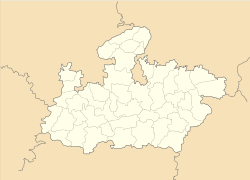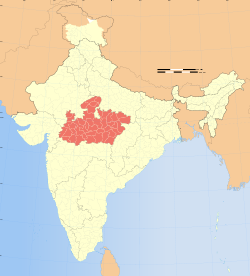Indore
| Indore इंदौर, इंदूर |
|
| The City of The Holkars, Mini Mumbai"[1] | |
| — City — | |
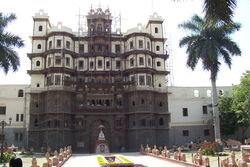 |
|
|
|
|
| Coordinates | |
| Country | |
| Region | Malwa |
| State | Madhya Pradesh |
| District(s) | Indore District |
| Mayor | Krishna Murari Moghe (Member of Bharatiya Janata Party) |
| Population • Density |
1,516,918[2] (2001[update]) • 9,718 /km2 (25,170 /sq mi) |
| Sex ratio | 0.715 ♂/♀ |
| Literacy | 71.69[4]% |
| Official languages | Hindi, English |
|---|---|
| Time zone | IST (UTC+5:30) |
| Area • Elevation |
3,898 square kilometres (1,505 sq mi)[5] • 553 metres (1,814 ft) |
| Climate • Precipitation |
Cfa (Köppen) • 945 mm (37.2 in) |
| Website | www.indore.nic.in |
Indore (Hindi: इंदौर, Marathi:इंदूर pronunciation), is a major city and commercial center of the state of Madhya Pradesh in central India. Indore city has a population of 1,516,918(2001 census),[2] the 15th [6] largest city in India and the 147th [7] largest city in the world. It serves as the headquarters of both the Indore district and Indore division.
During the days of the Maratha Empire it was an important halt between the Deccan and Delhi. However after the death of Madhavrao Peshwa, the Maratha Empire disintegrated and Indore was declared the capital of the Holkar state, until Rani Ahilyabai Holkar moved the capital to Maheshwar.
Contents |
Etymology
Theories explaining the origins and etymology behind Indore's name differ. Formerly, the city of Indore was known by many different names. The first expected name of the city was Indreshwar which was named after the Indreshwar Temple in the city. Before this name was used, it was known as Ahilyanagari (The city of Queen Ahilyabai Holkar).
- Year 1607 to 1794 - Ahilyanagari,
- Year 1800 to 1950 - Indhur,
- Year 1958 till Present - Indore
The present name, Indore, originated from the Indreshwar temple constructed in 1741 by Ved Manuj.[8]
History
The founders of Indore were the ancestors of the present zamindars of the region which spread from the banks of Narmada to the borders of Rajputana. Their headquarters were at a village called Kampel. In Mughal times, the founders of these families received the title of Chaudhari, which established their claim to the land. In the 18th century, the control of Malwa passed to the Peshwa clan, and the Chaudharis came to be known as "Mandloi"s (derived from Mandals meaning districts). The Holkars conferred the title of Rao Raja upon the family.[9] The family retained its possessions of royalty, which included having an elephant, Nishan, Danka and Gadi even after the advent of Holkars and also retained the right of performing the first puja of Dushera (Shami Pujan) before the Holkar rulers.
Under Mughal rule, the family enjoyed great influence and was accorded confirmatory sanads by the Emperors Aurangzeb, Alamgir, and Farukhshayar, confirming their 'Jagir' rights. Rao Nandlal Chaudhary Zamindar, upon visiting the court of Delhi, received a special place in the emperor’s court along with two jewel studded swords (now on display in the Royal British Museum under the family's name) and confirmatory sanads. Raja Savai Jai singh of Jaipur, a personal friend of his, gifted him with a special "Gold Langar" which guaranteed a special place to him in all the Durbars of India. The family’s respectability and influence over Malwa was instrumental in the ascent of the Peshwas and Holkars to rulership of this region.
Rao Nandlal Chaudhary, the founder of Indore, was the Chief Zamindar (landlord), and had an army of 2000 soldiers. In 1713, Nizam was appointed as the controller of the Deccan plateau area, which renewed the struggle between the Marathas and the Mughals.
While visiting the temple of Indreshwar near the banks of river Saraswati, Rao Nandlal found the location to be safe and strategically located, being surrounded by rivers on all sides. He started moving his people in, and constructed the fort of Shree Sansthan Bada Rawala to protect them from harassment by Mughals. The city was named Indrapur (after Lord Indreshwar), and eventually came to be known as Indore.
Baji Rao Peshwa finally took control of Malwa in 1733 A.D. Malhar Rao Holkar was one of the four signatories who guaranteed the proper fulfillment of the conditions.[10] Upon victory the Peshwas appointed Malhar Rao Holkar as a “Subhedar”, which marked the beginning of Holkars' reign in Malwa.[11][12][13][14][15][16][17][18][19]
Thus, Indore came to be ruled by the Maratha Maharajas of the Holkar dynasty. The dynasty's founder, Malhar Rao Holkar, (1694–1766), was granted control of Malwa Maratha armies in 1724, and in 1733, was installed as the Maratha governor of the region. By the end of his reign, the Holkar state was de facto independent. He was succeeded by his daughter Ahilyabai Holkar who ruled from 1767 to 1795. She ruled from a palace-fort at Maheshwar, south of Indore on the Narmada River. Ahilyabai Holkar was an architectural patron who donated money for the construction of Hindu temples across India. In 1818, the Holkars were defeated by the British in the Third Anglo-Maratha War, and the Holkar kingdom became a part of the British Raj. As a result of this defeat in the Battle of Mahidpur, the treaty of Mandsaur was signed, through which the Cantonment town of Mhow was handed over to the British. The treaty also decreed that the capital of the Holkar state would shift from Maheshwar to Indore.
In early 20th century, Indore was the home of Seth Hukumchand Jain, who became the first Indian to establish a jute mill in India. He is regarded to a pioneer of Indian industry, and a founder of several institutions and industries in Indore and nearby area.
After India's independence in 1947, Indore, along with a number of neighbouring princely states, became part of the Indian state of Madhya Bharat. Indore was designated the summer capital of this newly created state. On November 1, 1956, Madhya Bharat was merged into Madhya Pradesh and Bhopal was chosen as the capital. The city palace was the seat of administration of the rulers of the Malwa region – The Holkars (26 May 1728 to 20 April 1948).
Geography
Indore is located in the western region of Madhya Pradesh, on the southern edge of the Malwa plateau, on the Saraswati and Khan rivers, which are tributaries of the Shipra River. Indore has an average elevation of 550 metre above sea level. It is located on an elevated plain, with the Yadri range to the south.
Climate
| Indore | ||||||||||||||||||||||||||||||||||||||||||||||||||||||||||||
|---|---|---|---|---|---|---|---|---|---|---|---|---|---|---|---|---|---|---|---|---|---|---|---|---|---|---|---|---|---|---|---|---|---|---|---|---|---|---|---|---|---|---|---|---|---|---|---|---|---|---|---|---|---|---|---|---|---|---|---|---|
| Climate chart () | ||||||||||||||||||||||||||||||||||||||||||||||||||||||||||||
|
||||||||||||||||||||||||||||||||||||||||||||||||||||||||||||
|
||||||||||||||||||||||||||||||||||||||||||||||||||||||||||||
Indore has a transitional climate between a tropical wet and dry climate and a humid subtropical climate. Three distinct seasons are observed: summer, monsoon and winter. Summers start in mid-March and can be extremely hot in April and May. The highest temperature recorded was 48 °C in 1994. Average Summer temperatures may go as high as 42-44.c (100.4 °F) but humidity is very low. Due to Indore's location on the southern edge of the Malwa Plateau, a cool breeze (also referred to as Shab-e-Malwa) in the evenings makes summer nights quite pleasant. The monsoon season starts in late June, with temperatures averaging around 26 °C (79 °F), with sustained, torrential rainfall and high humidity. The average rainfall is 36 inches. Winters start in mid-November and are dry, mild and sunny. Temperatures average about 4–15 °C (39–59 °F), but can fall close to freezing on some nights. In summer temperatures can be sometimes as high as 48–50 °C (118–122 °F) and in winters it can be as low as 2 °C (36 °F).
Indore gets moderate rainfall of 35 to 38 inches (890 to 970 mm) during July-September due to the southwest monsoon.[20]
Civic Administration
| Indore City Officials | |
| Mayor | Krishna Murari Moghe[21] |
| District Collector | Raghvendra Singh[22] |
| Municipal Commissioner | C.B. Singh[23] |
| Inspector General of Police | Sanjay Rana[24] |
Indore is administered by the Indore Municipal Corporation. Some of the regions surrounding the city are administered by the Indore Development Authority(IDA). The IMC was established in 1956 under the Madhya Pradesh Nagar Palika Nigam Adhiniyam. For administrative purposes, the city is divided into 69 wards. These wards have been further divided into 11 zones.
The main institution involved in planning and development in Indore is Indore Development Authority(IDA). The jurisdiction of this agency is demarcated clearly not only physically but also functionally. The principal responsibility of IDA is to ensure a holistic development of the Indore agglomeration covering an area of 9.718 km² as per Master plans.[25][26]
The corporators are elected from each ward, who in turn elect a mayor. The mayor is responsible for the day-to-day running of the city services, municipal school board, the city bus service, the municipal hospital and the city library. Executive powers are vested in the municipal commissioner, who is an IAS officer appointed by the Madhya Pradesh state government. The Indore City Police are headed by a Inspector General, an IPS officer.
Demographics
Indore's total population in 2009 was reported to be 1,912,000.[7] Males constitute 53% of the population and females 47%.[27] As per 2001 census, the city of Indore has an average literacy rate of 75%, higher than the national average of 59.5%. Male literacy was 75%, and Female literacy was 64% [28] In Indore, 12.72% of the population is under 6 years of age (as per census 2001).[29] The average annual growth rate of population is around 2.85% as per the statistics of census 2001. Hindi is the main language spoken here with Marathi and Malwi spoken as well.
Transport
The major bus terminals are Sarwate bus terminal, Gangwal bus terminal, Navlakha bus stand & Jinsi bus stand.
Air
Indore is served by the Devi Ahilyabai Holkar domestic Airport. Indore airport is about 8 km from the city centre and currently handles only domestic traffic. The airport is served by Indian Airlines, Jet Airways, Jet Lite, Kingfisher Red and Go Air.
Rail

The City Railway Division comes under Ratlam Division of the Western Railways. Indore Junction BG is the main and terminal station on the broad gauge line connecting it to the rest of the country. In the Railway budget of 2009 Indore main railway station was listed for transformation to a modern railway along with other 300 stations across India.
Indore is one of the several places in India with both meter gauge and broad gauge railways operational. Regular train services connect Indore to most parts of the country. Electrification of the Indore - Dewas - Ujjain is currently underway.
Indore lies on the Ratlam and Akola metre gauge railway line, the longest remaining functional meter gauge line in India. This section is scheduled for conversion to standard broad gauge under Indian Railways' projected Unigauge system.
Road
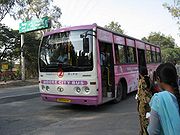
Indore is well connected to other parts of India through national and state highways. There are some major highways which pass through Indore and connect it to some major cities. The major national highways passing through the city are:
- National Highway No. 3 (NH3 - Agra Bombay)
- National Highway No. 59 (NH 59 - Indore Ahmedabad)
- National Highway No. 59A (Indore - Betul)
The Mumbai- Indore section of the National Highway No. 3 and the Ahmedabad - Indore section of the National Highway No. 59 are undergoing multi laning under the NHDP program. Other important regional highways are:
- State Highway No. 27 (Indore to Khandwa)
- State Highway No. 34 (Indore to Jhansi)
Local Transport
Indore has an efficient public transport system. Atal Indore City Transport Services Ltd, a PPP scheme operates buses and radio taxis in the city. The buses - designated as City Bus today ply on 36 Routes, with around 170 Bus Stop Stations. There are 225 General Low Floor, 190 Semi-Low Floor and 90 AC Special City Bus being operated under this new service. The buses are color coded as per their route.
Some of these buses are also equipped with advanced services like GPS and IVR (around 300) which are used to track the position of the bus in real time. This information is displayed on LED displays installed on the Bus Stops.
For local transport, there are also the options of Auto rickshaw, Van and Local City Ride Buses called Nagar Seva.
Economy
Indore is the commercial capital of Madhya Pradesh with a bulk of its trade coming from Small, Mid and Large scale manufacturing & service industries. These industries range from Automobile to Pharmaceutical and from Software to Retail. Major industrial areas surrounding the city include the Pithampur Special Economic Zone and the Sanwer Industrial belt. Pithampur is also known as the Detroit of India.[30][31]
Education
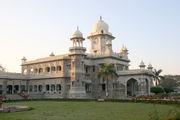
Home to a range of colleges and schools, Indore has a large student population and is an educational centre. Most primary and secondary schools in Indore are affiliated with the Central Board of Secondary Education (CBSE); however, a number of schools have affiliation with ICSE board, NIOS board and the state level M.P. Board.
Devi Ahilya Vishwavidyalaya(DAVV), is the major & oldest university of Indore, offering courses in more than 20 fields ranging from law to pharmacy to management at both graduate and postgraduate level.
Mahatma Gandhi Memorial Medical College, one of the oldest medical college in country offers varied range of courses in medical sciences.
Having both Indian Institute of Management and Indian Institute of Technology in Indore making it the only city in the country to have both of these institutions.
Media
Arts and theater
Ravindra Natya Grah is an important and well known center for theatre and performing arts in the city. Many artists from around the world perform here regularly. Abhivyakti Centre of Fine Arts & Performing Arts, Deolalikar Kala Vithika are also similar centers for arts and theatre.[32] There are also various cultural clubs like Ras Bharati and Kala Abhivyakti, Who invite performers from around the globe to perform in Indore. Yeshwant Club and Sayaji Club also sponsor and invite talents from across world.
Electronic media
The radio industry has expanded with a number of private and government owned FM channels being introduced. The FM radio channels that broadcast in the city include AIR Vividh Bharathi FM (101.6 MHz), Radio Mirchi FM (98.3 MHz), Big FM (92.7 MHz), Red FM (93.5 MHz), My FM (94.3 MHz) and AIR Gyan Vani FM (105.6 MHz). State-owned Doordarshan transmits two terrestrial television channels. Apart from these few local broadcasting stations also exist.
Print media
There are about 19 Hindi dailies, two English dailies, 26 weeklies and monthlies, 3 quarterlies, 1 Bi-monthly Magazine and one annual paper published from the city.[33] The major Hindi dailies include the Nai Dunia, Dainik Bhaskar, Dainik Jagran, Patrika, Raj Express, Agnibaan, & PrabhatKiran. The major English dailies are The Times of India, Hindustan Times, The Hindu, Free Press, Business Standard & The Economic Times.
Communication services Indore is covered by a large network of optical fibre cables. There are three fixed telephone line operators in the city: BSNL, Reliance and Airtel. There are Seven mobile phone companies in which GSM players include BSNL, Reliance, Vodafone, Idea, Airtel, Aircel, Tata DoCoMo, CDMA services offered by BSNL, Virgin Mobile, Tata Indicom and Reliance.
Sports

Indore has two stadiums, Nehru Stadium and Holkar Cricket Stadium.[34] There are many sports club for various sports. Lawn tennis - Indore Tennis Club, Indore Residency Club. Basket Ball - Basket Ball Club. Table Tennis - Abhay Khel Prashal Kabaddi - Lucky Wanderers, Chess - SKM Chess Academy Indore is also a traditional powerhouse for the game of basketball which has been growing in popularity over the last 3 to 4 decades. It is the home of India's first National Basketball Academy and has a world class indoor basketball stadium. Indore has successfully organised various National Basketball Championships. The list of noted players include C. K. Naidu (ex. Capt. Indian Team), Jamshed Nusserwanji Bhaya, Mushtaq Ali(ex. Capt. Indian Team), Hiralal Gaekwad, Narendra Hirwani Naman Ojha (Rajasthan Royal IPL) . Other well-known sportspersons are late Dr. Sharma (Basketball), Kishan Chand, Shankar Lakshman and Saleem Sherwani (hockey), Kripa Shankar Patel (Olympian wrestler).
Culture
Indore city has a variety of cultures. Over the years the city of Indore has welcomed people from all castes, creed and colour. People from all corners of the country have migrated & settled in the heart of Madhya Pradesh for their livelihood, education or just for its peaceful culture. People here know to maintain harmony by intermixing and enjoying their life, irrespective of castes or region and by respecting every religion. A city with abundant social life, Indore was included in the Guiness Book of World Records[35] for holding the largest tea party in the world.
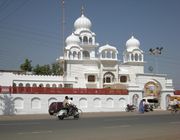
Food
Indore is famous for its culinary range and is known for its wide variety of Namkeens, Poha & Jalebi, Chaats (snacks), Kachoris and Samosas, cuisines of various types in different restaurants, and Bengali, Muslim, Rajasthani, continental and confectionery sweets, as well as exotic dishes such as Dal-Bafla, Nihari Gosht and Bafla-Gosht - a delicacy of Indore and Malwa Region.
Main festivals
All national festivals like Holi, Baisakhi, Raksha Bandhan, Navratri,Dussehra, Ganeshotsav, Deepavali, Ramzan, Gudi Padwa, Bhaubeej, Eid and other others like Nagpanchmi, Ahilya Utsav, are celebrated with equal enthusiasm.
Places of interest
- Annapurna Temple - A Hindu temple, primarily of goddess Annapurna, in the west region of the city.
- Bada Ganpati Temple - This temple houses Ganesha Deity, measuring 25 ft. from crown to foot.
- Crystal Temple - Digambar Jain temple built by Seth Hukumchand a century ago, with exquisite glass work.
- Deoguradia - The monolithic rock temple built in 7th century. The original Shivalinga is 12 ft under water in a sunken temple above which the present temple is constructed.[36]
- ISKCON - Sri Sri Radha Krishna Temple, Hare Krishna Movement in Nipaniya Village, MR 10, Devas Bypass Road.
- Gomat Giri - A Jain (disambiguation) temple with 21 feet statue of Gomateshwara, a replica of the Bahubali statue of Shravanabelagola. Along with 24 marble temples with shikhars, for each Tirthankar.[37]
- Krishnapura Chhatri - By the banks of the Khan river, it is at a walking distance from Rajwada.
- Lal Bagh Palace - A palace spread across 200 acres (0.81 km2) of land. It is now a museum and one can see the artefacts of the Holkar era.
- Rajwada - A seven-storey palace built during the Holkar era.
- Zoo - The zoo in Indore is famous for its unique collection of animals.
- Museum - The Indore museum houses the finest collection of Parmar sculptures from Hinglajgarh [38]
Gallery
 The Rajwada Palace of Indore |
A Chhatri dating to Holkar period |
Krishnapura Chhatri. |
||
 Krishnapura Chhatri |
Sculptures on Krishnapura Chhatri |
Krishnapura Chhatri from inside |
Carvings at Krishnapura Chhatri |
Carved Pillars of Krishnapura Chhatri |
|
Intricate Sculptures on Krishnapura Chhatri |
Vijay Balla |
 Treasure Island Mall, First in Madhya Pradesh |
 Polluted Khan River. Krishnapura Chhatri in background. |
See also
- Bijalpur
- Rau
- Mhow
- Kshipra
- Dewas
- Ujjain
- Rangwasa
- Manpur, Indore
- Betma
- Burhanpur
- Omkareshwar
- Mandu
- Maheshwar
- Pithampur
References
- ↑ "" Best cities to work, play and live "". Business Today. http://businesstoday.intoday.in/index.php?option=com_content&task=view&issueid=48&id=11655&Itemid=99999999§ionid=22&completeview=1. Retrieved 2009-06.
- ↑ 2.0 2.1 Indore Population. Census of India. Retrieved 04 July 2010.
- ↑ [1] City Mayors & Tann vom Hove. Retrieved 4 July 2010
- ↑ [2]. Literacy rate. Retrieved 08 Aug 2010.
- ↑ [3]. Area of Indore census 2001. Retrieved 08 August 2010.
- ↑ ""Some 108 million people live in India's largest cities"". City Mayors. http://www.citymayors.com/gratis/indian_cities.html. Retrieved 2010-07-04.
- ↑ 7.0 7.1 ""The world's largest cities"". City Mayors. http://www.citymayors.com/statistics/largest-cities-mayors-el.html. Retrieved 2010-07-04.
- ↑ "Now, Indore to become Indur". Online Edition of The Times of India, dated 2006-12-18. http://timesofindia.indiatimes.com/articleshow/828162.cms. Retrieved 2009-09-21.
- ↑ Major General Sir John Malcolm, Central India, Part I, pp. 68-70
- ↑ Major General Sir John Malcolm, Memoirs of Central India, Vol. I. pp.94-95
- ↑ Major General Sir John Malcolm, Memoirs of Malwa (1912)
- ↑ Patrick Geddes, "City Development", in A report to the Durbar of Indore Part 1. Indore:Historic Development" (1918)
- ↑ Sukh Sampatti Rai Bhandari, History of the Indian States, Rajya Mandal Book Publishing House (1927)
- ↑ "Malwa in Transition A Century of Anarchy", The First Phase 1698-1765 by Raghubir Singh of Sitamau. Year 1936.
- ↑ "The Indore State Gazetteer". Volume 1-printed Under the authority of the Government of His Highness the Maharaja Holkar. Superintendent Holkar Government Press, Indore 1931.
- ↑ "Memoirs of Central India", Volume I. by Major General Sir John Malcolm. Year 1823.
- ↑ "Indore Holkar State Gazetteer". No.23, 1875.
- ↑ "Malwa Sahitya". 5th Year Issue No.1. Year 1855.Indore.
- ↑ "The Mandlik Papers and the Family". by Sardar M.V.Kibe. 1946.
- ↑ FallingRain Map - elevation = 545m
- ↑ "Indore Parshad/Mayor". Indore Municipal Corporation. 2010-08-08. http://www.imcindore.org/parshad.jsp. Retrieved 2010-08-08.
- ↑ "From The Collector's Desk". Indore District Administration. 2010-03-17. http://www.indore.nic.in/collector.htm. Retrieved 2010-05-13.
- ↑ "IMC Contact Numbers". Indore Municipal Corporation. 2010-05-13. http://www.amdaindia.org/administrativestr.asp. Retrieved 2010-05-13.
- ↑ "Officers". Indore Police. 2010-05-13. http://www.indorepolice.org/contact-officers.php. Retrieved 2010-05-13.
- ↑ "About IDA". Indore Development Authority. http://www.idaindore.org/AboutIDA.aspx. Retrieved 2010-05-13.
- ↑ "Indore Development Plan 2021". Directorate of Town & Country Planning. 2010-05-13. http://mptownplan.nic.in/New%20Folder%20%282%29/summary.htm. Retrieved 2010-05-13.
- ↑ ""Census India reports"". India census. http://web.archive.org/web/20040616075334/http://www.censusindia.net/results/town.php?stad=A&state5=999. Retrieved 2010-08-08.
- ↑ Statistics of Indore. District Administration of Indore. Retrieved 16 August 2009
- ↑ ""Census India reports"". India census. http://web.archive.org/web/20040616075334/http://www.censusindia.net/results/town.php?stad=A&state5=999. Retrieved 2010-08-08.
- ↑ Tiwary, Santosh (1998 -04-01). "Pithampur small enterprises tell a tale of untapped potential". Indian Express. http://www.expressindia.com/news/fe/daily/19980104/00455324.html. Retrieved 2009-09-01.
- ↑ Trivedi, Shashikant (2004-07-09). "Pithampur units face bleak future". Business Standard. http://www.business-standard.com/india/storypage.php?autono=153051. Retrieved 2009-09-01.
- ↑ "Abhivyakti,". http://www.shiksha.com/getListingDetail/2296/institute/college-Abhivyakti-Centre-Of-Fine-Arts-Performing-Arts-Bhopal-India/.
- ↑ Indian Journal of Science Communication (Volume 2/ Number 1/ January – June 2003) http://www.iscos.org/vol3/rp1.htm
- ↑ "Usha Raje is now Holkar cricket stadium". Dainik Bhaskar Online Edition, dated 2010-08-23. http://www.bhaskar.com/article/MP-IND-usha-raje-holkar-cricket-stadium-now-1286044.html. Retrieved 2010-08-29.
- ↑ "Largest Tea Party at Indore". Guinessworldrecords. 2008-02-25. http://www.guinnessworldrecords.com/records/amazing_feats/mass_participation/largest_tea_party.aspx. Retrieved 2010-03-12.
- ↑ "Deoguradia". Indore District & Administration. 2010-03-23. http://www.indore.nic.in/place.htm#deo. Retrieved 2010-03-23.
- ↑ "Gomat Giri". Indore District & Administration. 2010-03-23. http://www.indore.nic.in/place.htm#gomatgiri. Retrieved 2010-03-23.
- ↑ "Indore Museum". Indore District & Administration. 2010-03-23. http://www.indore.nic.in/place.htm#museum. Retrieved 2010-03-23.
Further reading
- Hunter, Cotton, Burn, Meyer. "The Imperial Gazetteer of India", 2006. Oxford, Clarendon Press. 1909.
- Plunkett, Richard. Central India. Lonely Planet, 2001. ISBN 1-86450-161-8
- "Indore." Encyclopedia Britannica. 1911 ed.
External links
- City portal at Govt. of India info. website
- Indore Municipal Corporation website
- Indore Police Official Site
- Indore travel guide from Wikitravel
- Indore at the Open Directory Project
|
||||||||
|
||||||||
|
||||||||||||||||||||||||||||||||
